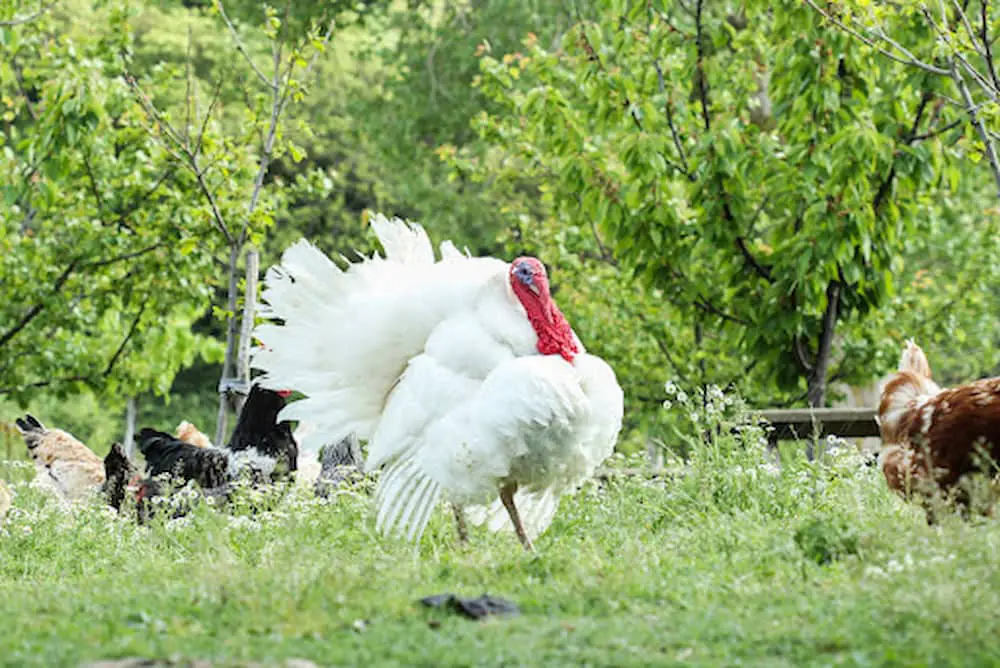Many people don’t think about turkey until Thanksgiving rolls around. For this reason, most people don’t know that there are many breeds of turkey. However, one turkey breed that you want to know about this Thanksgiving is the White Holland turkey.
The White Holland turkey is known for its large breast, long legs, and white plumage, which had also proven to benefit the bird in the past and is one reason it was so popular. In contrast to darker-colored birds, the carcass of the White Holland turkey was easier to clean for commercial use.
But why have you never heard of it? Keep reading to learn more about the White Holland turkey, including its origins, characteristics, and what it’s used for.
What Are White Holland Turkeys?
The White Holland turkey is a very old variety of turkey found in the United States.
Learn how to raise your own quail and have an unlimited supply of eggs and meat.
While you may not have heard of them today, White Holland turkeys have been a significant breed throughout American history. Throughout the early 20th century, they were the most important commercial bird.
In fact, you can consider the White Holland variety the mother of the most common turkey breed today, the Broad Breasted White turkey. The White Holland turkey was bred in the 1950s to create the bigger, Broad Breasted White turkey, which took over the market. The White Holland can also be credited for another small rare white turkey, the Beltsville Small White turkey breed.
The popular past of the White Holland turkey is in stark contrast to their sparse present, where they are no longer a commercially successful bird due to how rare they’ve become.

Today, the rarity of the White Holland turkey characterizes it as a heritage turkey, meaning a rare type of turkey that has characteristics no longer found in today’s commercial turkeys. It is also listed as threatened by the Livestock Conservancy.
Unfortunately, in some places in Britain and the United States, White Holland turkeys are sometimes not differentiated from Broad Breasted White turkeys. Worse yet, in Britain, all white turkeys are under one classification of “white turkeys.”
This classification takes away the unique nature and quality of the White Holland, which deserves recognition for its special features that gave birth to other turkey varieties. Thankfully, breeders are working to preserve the distinguishing features of the White Holland turkey.
Let’s look at some of the characteristics of White Holland turkeys.
Characteristics of White Holland Turkeys
Despite their name, the origins of the White Holland turkey aren’t conclusive on whether it is from the Netherlands. However, research suggests that it was maybe brought over from Europe, as white turkeys were popular there.
Other physical characteristics of the White Holland turkey include its red/bluish head, dark beard, pink beak, and pinkish-whitish horn throat and wattles, making it a unique-looking bird. In terms of personality, they are similar to other turkeys in that they are friendly and docile – however, this temperament largely depends on the breeder.
The White Holland turkey is also smaller than many of the turkeys we’re used to today and was smaller than the Bronze turkey, despite being more popular. An adult White Holland would weigh about 25 pounds. They eventually cross-bred the two birds to create the popular Broad Breasted White turkey, giving both parent breeds a run for their money.
This begs the question, are White Holland turkeys still eaten today? What else are they used for? Let’s take a look.

What Are White Holland Turkeys Used For?
While White Holland turkeys are still raised for meat production today, their rarity has caused them not to be so heavily commercialized and consumed.
However, for the same reason, you’ll often find these turkeys in the hands of bird enthusiasts. You’ll often see them in poultry shows being shown off as the rare birds that they are. They must also be carefully bred to maintain their characteristic features.
How to Raise White Holland Turkeys
Raising a White Holland turkey is entirely doable, and there are several reasons you may consider wanting to raise them, from having a fun pet to showing it off to other poultry enthusiasts.
In general, if you were interested in White Holland turkeys today, it would be costly. While raising White Hollands is similar to raising other turkey breeds, because this breed is so rare, it takes high upfront costs to acquire one.
That said, they are a rewarding breed to consider raising. As a heritage turkey, they have more primal instincts than other domesticated breeds and thrive best in a free-range environment. Just ensure they are in an enclosure that protects them from predators and prevents them from wandering off.
Overall, these turkeys are friendly and look great, as far as turkeys go. They also make fantastic pets. Breeding these turkeys is a challenging project if you are a dedicated poultry breeder, but it may end up being rewarding.

White Holland Turkeys – Threatened, But Not Soon to Be Forgotten
In summary, the White Holland variety is considered a rare breed today but was once the most prominent and important breed of bird in the United States. A former star of American Thanksgiving, this turkey is now threatened and no longer consumed on a large scale.
However, it’s essential to acknowledge that the White Holland turkey has contributed to our continued turkey consumption today through other, newer breeds. Although the Broad Breasted White turkey has overshadowed them, we will not soon forget the contributions of the White Holland turkey.

